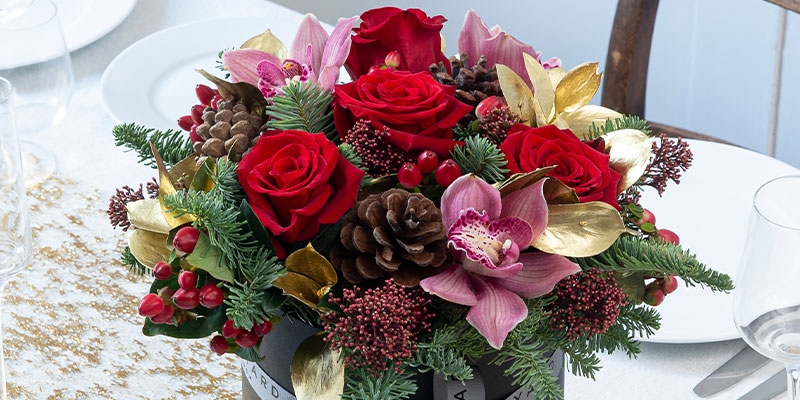
Learn all about our favourite festive floral traditions from around the globe.
Here in the UK, decorating a Christmas tree with colourful baubles and glittering fairy lights heralds the start of our festive season. Foliage, fir cones and berries are woven together into abundant Christmas wreaths for our front doors, and sprigs of holly adorn mantlepieces up and down the country.
But the British aren’t the only ones inspired by the natural world when decking their halls for December. Let’s take a snowy stroll through the Christmas flowers and plants that hold a special place in the heart of other nations’ traditions. Because from pomegranates to poinsettias, there’s more to celebrate than our beloved bejewelled conifers.
Pomegranate
In Greece, no Noel is complete without a plentiful harvest of pomegranates; often depicted on Christmas cards and made out of clay, glass or metal for gifting and display, this bauble-like fruit is a national seasonal symbol.
Traditionally symbolising fertility – pottery pomegranates were often dedicated to Hera, the goddess of motherhood – they now also represent prosperity, perhaps on account of the ‘jewels’ that spill forth once opened.
Modern Greeks hang a single pomegranate above their front door on Christmas Day, before smashing it on the doorstep just after midnight on New Year’s Day to ensure a new year full of fortune for their family.
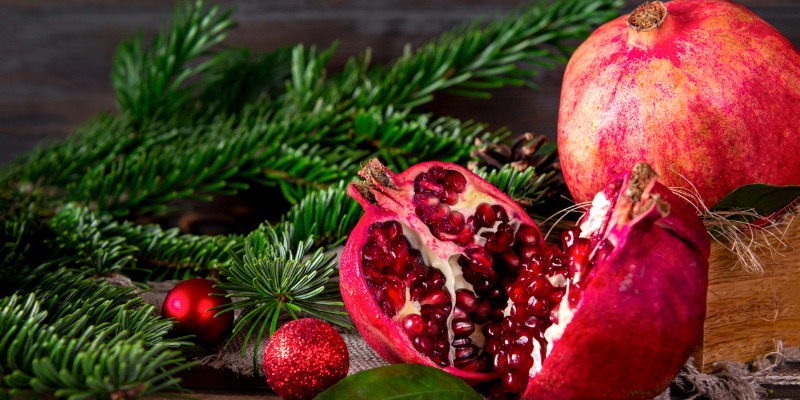
Poinsettia
Poinsettias may have become a festive staple here in the UK, with some eight million plants sold every year, but these red-leaved beauties actually hail from Mexico, where they play a role in Christmas folklore.
Legend has it that way back in the 16th century, a poor young girl couldn’t afford a gift to take to the baby Jesus at a Christmas service. She was encouraged by an angel to pluck a sprig of weeds from the roadside and place her humble offering at the altar. Upon doing so, it burst into a magnificent poinsettia, with the plants henceforth known as ‘Flores de Noche Buena or ‘Flowers of the Holy Night’.
Today, poinsettias are named after the first US ambassador to Mexico, Joel Roberts Poinsett, who brought them back to his country in the early 1800s. They have retained their religious connotations; the red colour is said to symbolise the blood of Christ, and the star shape, the Star of Bethlehem that guided the wise men to Mary, Joseph and the newborn in the Bible story.
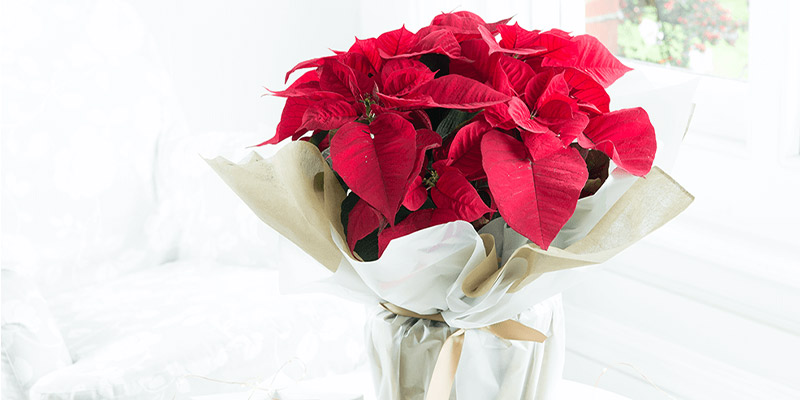
Hydrangea
Hydrangeas, in December? Don’t forget that in the southern hemisphere, it’s summer. In South Africa, these showy blooms are flowering in their pretty pastel tones of pink, blue and white. Given how showstopping they make any floral display, it’s little wonder that these ‘Christmas roses’ are a favoured festive gift over 5,000 miles away.
New this Christmas, our opulent Winter Hydrangea bouquet features pink hydrangeas, red hypericum berries and shimmering copper eucalyptus. Prefer understated neutrals? Our Champagne Fizz is a winter wonderland of white hydrangeas, cream roses and frosted silver asparagus fern.
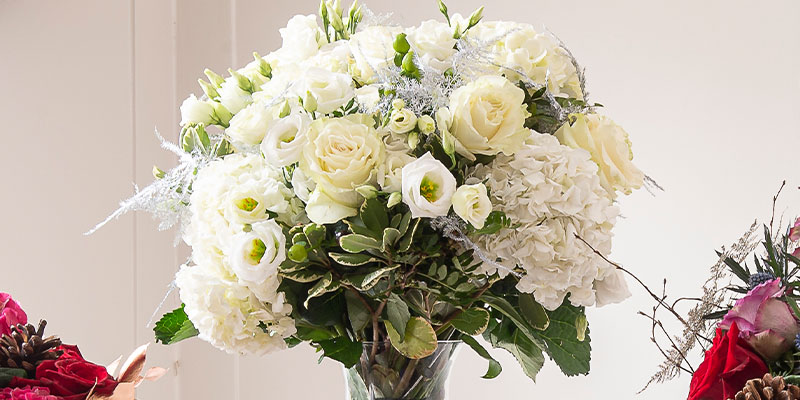
Apple
The humble apple enjoys a starring role in China, where it is wrapped or stamped with a festive message and presented as a gift on Christmas Eve. Why? Because ‘Christmas Eve’ is known as the ‘Night of Peace’, which translates to ‘Ping’an Ye’ in Mandarin and sounds like ‘pínggu’, the word for ‘apple’.
Wheat
In Croatia, it is traditional to grow wheat in the run-up to Christmas for use as table decoration on the big day, tied with ribbon in the red, white and blue of the Croatian flag. Travel to this Slavic nation in early December and you’ll find packets of grain in the shops, such is the importance of upholding this centuries-old custom.
Most families grow their ‘božićna pšenica’, or ‘Christmas wheat’ in small saucers, with the fresh green shoots bringing a touch of spring to bleak midwinter. The taller and lusher your crop grows, the more good luck the coming year will bring.
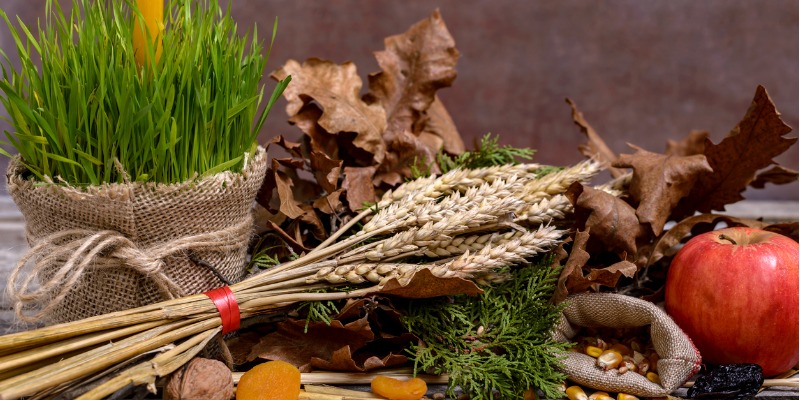
Radish
Let’s return to Mexico, for an even quirkier Christmas tradition. The ‘Noche de Rábanos’ or ‘Night of the Radishes’ is an event held every 23 December in Oaxaca, during which oversized radishes (some are 50cm long and weigh up to 3kg) are carved to create intricate sculptures in a bid to win prizes. Designs are often themed around Oaxacan history and culture but have included everything from snowmen to monsters.
So how on earth did this come about? Well, during the colonial period, when the Spanish introduced radishes, talented farmers began carving the vegetables into religious figures to attract shoppers at the city’s annual Christmas market. They proved popular, with locals buying them to use as Christmas centrepieces.
In 1897, Oaxaca’s mayor declared an official radish-carving competition and it remains a serious matter; government-owned land is dedicated to the growing of radishes used for the contest, which is attended by thousands of visitors and sparks hours-long queues. Sorry, pumpkins; it’s not all about you.
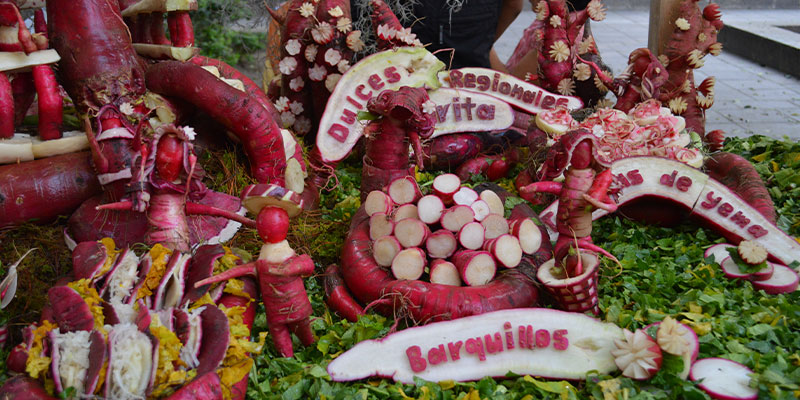
Chrysanthemum
Old German legend tells how a peasant family welcomed a beggar into their Black Forest home one snowy Christmas Eve. They wrapped him in blankets and let him share their supper, despite not having much for themselves. When the beggar warmed up, he revealed himself to be Christ and fled, leaving two white chrysanthemums on the doorstep.
In remembrance of this holy story, many Germans display white chrysanthemums at Christmas to symbolise their own willingness to shelter Christ. Today, white chrysanthemums are more commonly linked with death, making them a popular funeral flower, but this tale links them with birth, blessedness and gratitude.
There are no white chrysanthemums in our Christmas range this year, but you’ll find lush green ones complementing fiery orange roses in our Winter Spice bouquet, regal purple chrysanthemums in our fabulous Golden Fig, and rich red blooms in the luxurious Festive Rose Garden.
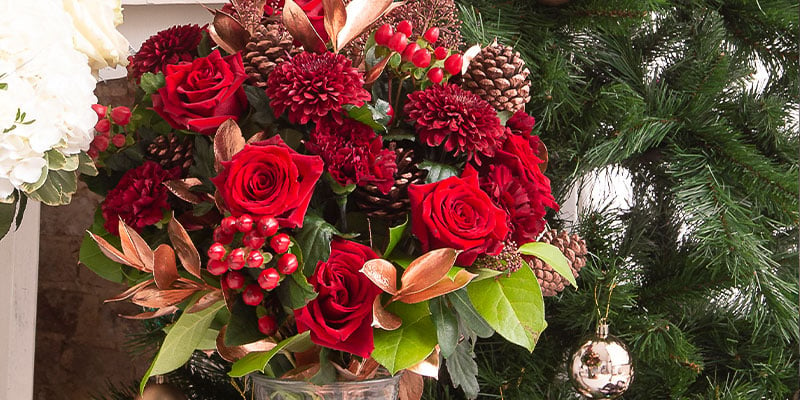
Hawthorn
Those Mexicans certainly know how to throw a party, with a little help from Mother Nature. The sweet orange fruits of their native hawthorn tree, known as ‘manzanitas’ or ‘little apples’, are threaded onto garlands, made into candy, jam and jelly, and used to make the traditional hot ‘Ponche Navideño’ or ‘Christmas punch’ that is served at festive shindigs.
Mexican hawthorn is hardy, surviving temperatures as low as -10°C, making it a fantastic year-round patio shrub to grow here, too.
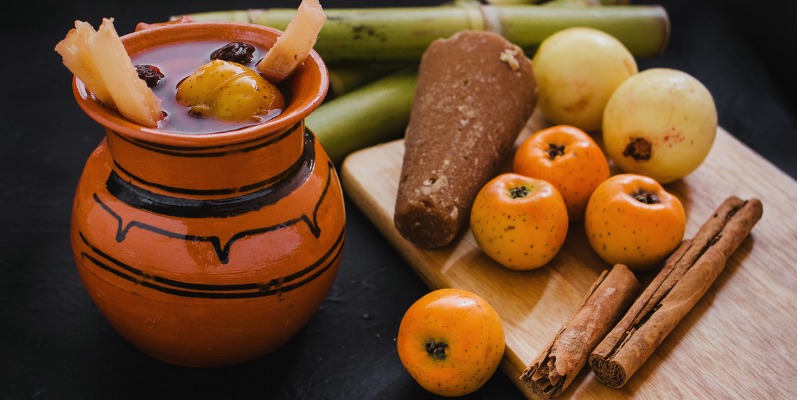
Mistletoe
The Europe-wide tradition of kissing under mistletoe harks back to Norse mythology, when it symbolised friendship and the healing of wounds. During the Christmas season of peace and goodwill to all men, enemies who met under those iconic sprigs of white berries would lay down their arms and exchange amicable, if far from romantic, greetings.
The kissing custom began in England in the early Georgian period, when mistletoe would be hung from a popular Christmas decoration called a Kissing Bough – essentially five wooden hoops shaped into a ball. Illustrations depicting kissing under the mistletoe were later published in Charles Dickens’ 1843 novel, A Christmas Carol.

Christmas Orchid
In South America, the ‘orquídea de navidad’ or ‘Christmas orchid’ is grown all over the continent for its creamy star-shaped flowers. Native to Madagascar, it is also called ‘Estrella de Belén’ or ‘Star of Bethlehem’ and is considered a festive favourite.
There are gift-wrapped orchids aplenty in our striking range, with the white cymbidium variety taking centre stage among roses, lisianthus and wintry foliage in our decadent Festive Forest bouquet.
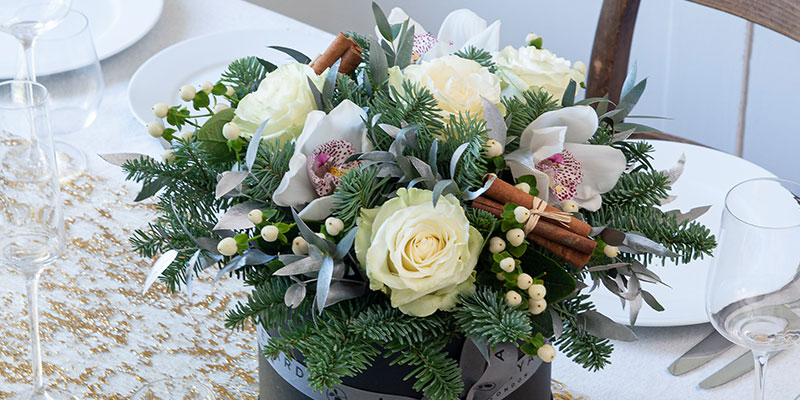
Yule Log
Originally a Nordic tradition but now popular throughout Europe, burning a Yule log predates the medieval period. Scandinavia’s Winter Solstice festivals used to be called Yule, and the ‘log’ was formerly an entire tree that was ceremoniously brought into the home before its thickest end was lowered into the fire. The rest of the log would be fed into the hearth throughout the Twelve Days of Christmas, with any remains stored away and used to light the following year’s festive fuel.
In Provence, in the south of France, families cut their Yule log down together and sprinkle it with wine for a festive scent as it burns. If any is left after Twelfth Night, it is kept in the house for protection against lightning.
If playing with fire sounds like a recipe for disaster in your household, feasting on a chocolate Yule log sounds like a delicious alternative to us.
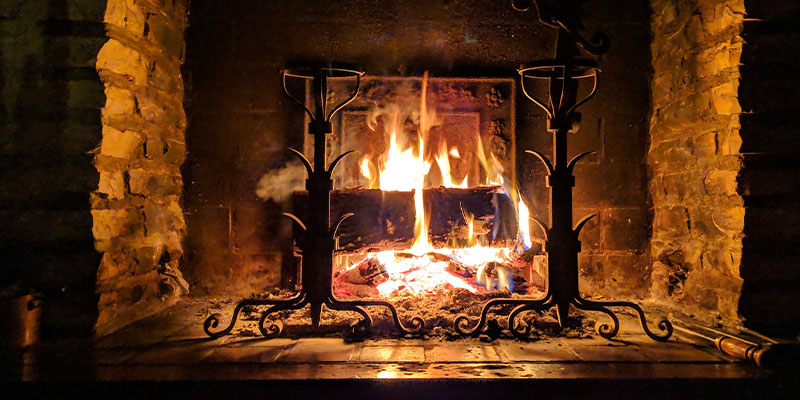
Hellebore
Widely known as the ‘Christmas rose’, ‘snow rose’ or ‘winter rose’, dainty hellebores bloom across central Europe for Orthodox Christmas, which takes place roughly two weeks after 25th December. For some, it is traditional to plant a hellebore near the front door to represent welcoming Christ into their home. Why not pick up our stylish white hellebore plant to take to your next dinner party?
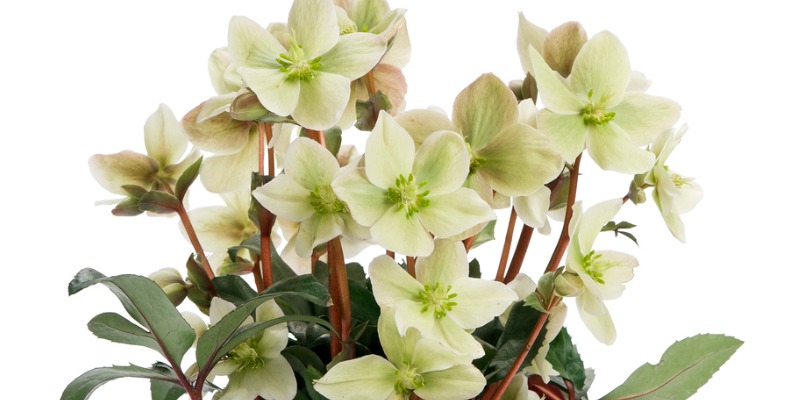
Christmas is a time for spoiling your loved ones (and yourself, of course), so enjoy a floral feast for the eyes with Appleyard’s stunning range of festive flowers. Shop now and save £12 when you buy two or more Christmas bouquets.
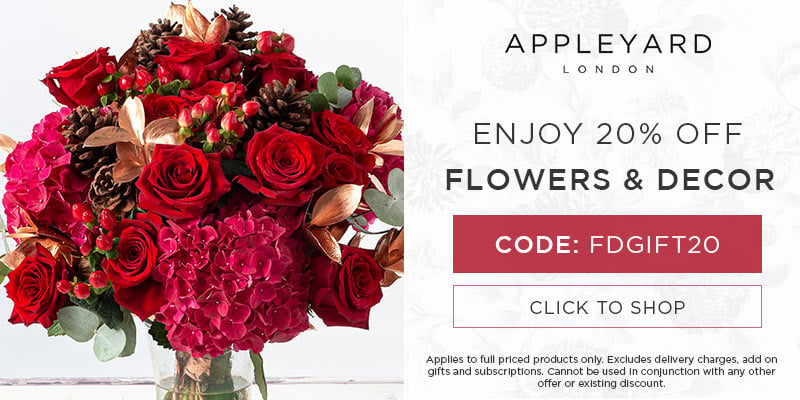

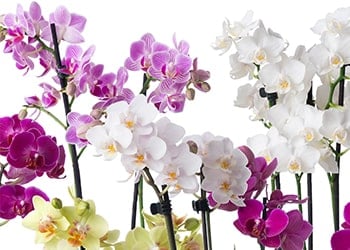




